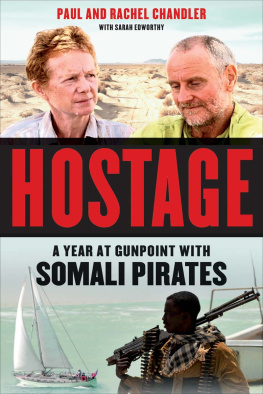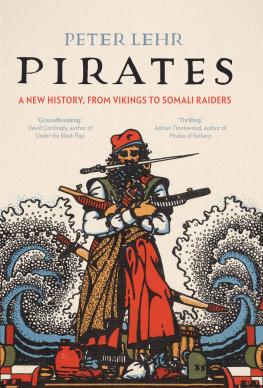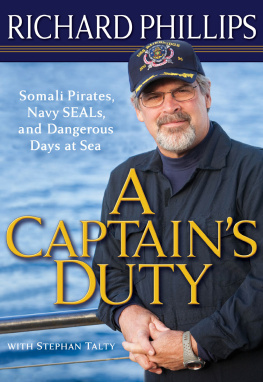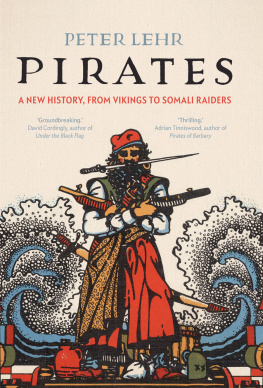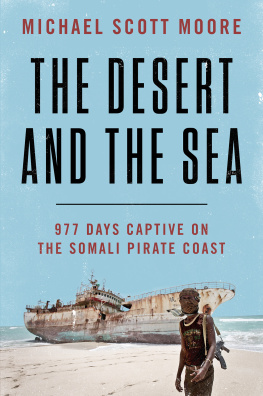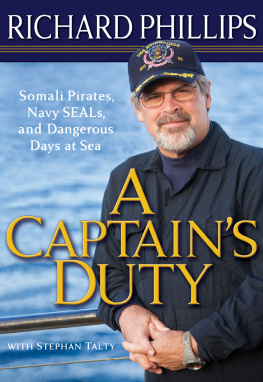
Paul Chandler is a Cambridge-educated civil engineer and Rachel Chandler is a former government economist. Both have a passion for sailing and travelling, and honed their seamanship skills over some 30 years in the waters around the UK and the Mediterranean. The couple have enjoyed a part-time sailing lifestyle since retiring from full-time employment in 2005.
Sarah Edworthy has been a journalist since 1987, and has been on the staff of the London Times and the Daily Telegraph. She has cowritten three other books. She lives in London.

Copyright 2011 by Paul and Rachel Chandler
Postscript copyright 2012 by Paul and Rachel Chandler
All rights reserved
First US edition
Published by Chicago Review Press, Incorporated
814 North Franklin Street
Chicago, Illinois 60610
ISBN 978-1-61374-442-0
Cover design: Jonathan Hahn
Cover images: Somali pirate AFP/Getty Images; image of Rachel and Paul supplied by Channel 4 News; all other images courtesy of Rachel and Paul Chandler
Library of Congress Cataloging-in-Publication Data
Chandler, Paul, 1950 Sept. 28
Hostage: a year at gunpoint with Somali pirates / Paul and Rachel Chandler ; with Sarah Edworthy.
p. cm.
Originally published as: Hostage: a year at gunpoint with Somali gangsters. Edinburgh: Mainstream Publishing Company, 2011.
ISBN 978-1-61374-442-0 (pbk.)
1. Chandler, Paul, 1950 Sept. 28-2. Chandler, Rachel, 1953- 3. KidnappingSomalia--21st century. 4. HostagesSomalia21st century. 5. PiratesSomalia--21st century. I. Chandler, Rachel, 1953- II.
Edworthy, Sarah. III. Title.
HV6604.S58.C43 2012
364.154092--dc23
2012009964
Printed in the United States of America
5 4 3 2 1
To the hundreds of seafarers held hostage by Somali pirates and to their families. You are not forgotten.
Contents
Glossary
Transliterations of Somali words as recorded in our diaries.
abbay father
adan white
af tongue
alen tea leaves
ambi mango
aniga I/me
ari goat
ashok supper
athiga you
baholi bowl
banjo fat
barballe bottle
baree tomorrow
basto spaghetti
behr liver
bes-bes chilli
bilod months, moons
bim the sound of a gunshot
biu water
bocol 100
briis rice
brr bread
budde small boat
cabadi later, after
cadu lunch
chad narcotic green plant
contun 50
courrah breakfast cun 1,000
dabagaale squirrel-like animal
daqika minute
deri tall
digir beans
doxi fly
ell well
fadlun please
ghodarr vegetable sauce
gil camel
guri house
habeen evening
hadha now
hal 1
halkan outside
halkas inside
haram forbidden
hilip meat
ho here!
kam how many?
ken give me
kiss kiss step by step
kitab book
kursi chair
lin lime
lin bombelmo grapefruit
lobaten 20
lobo 2
maawiis skirt worn by Somali men
magaa name
magas scissors
mahatsenit thank you
mahwille leader
maia no
malmod days
mante today
midi knife
mort killed
nag(ti) (my) woman
nin man
pochuko barbecue
Riija Rachel
sadambe day after tomorrow
sadden 30 sadeh 3
sagara small deer
sahibki friend
sano year
segashen 90 sheh tea shun 5
sideeten 80 son fast (not eating)
sooker sugar
tadobaad week
tadobo 7
toban 10
trrup playing cards
tuk thief
wahir small
wain big
yr and
Prologue
Early December 2009
Shrouded in white tarpaulin, with her name heavily taped over, a 38-foot yacht arrives by road at Bucklers Hard, near Lymington in Hampshire. Without ceremony, the anonymous boat is propped up on sturdy timbers to wait for her owners to claim her. The boatyard is almost full to capacity now that the last few haul-outs are done. Owners come and go, winterising their vessels draining engine oil, topping up anti-freeze, removing berth cushions and other items prone to mildew. Repairs are carried out at slow tempo in nearby sheds. Boats are given one last look over, then securely covered. Its a time for reflection. The end of one sailing season is the cue to dream about the next.
Shrewd winter winds play on the tarpaulins, then abate and blow more freshly as if keen to fill sails. In early spring, owners return to check their boats, discuss estimates for works and prepare for launch. The yard once again bustles with workers carrying out maintenance, installing new equipment, moving boats in and out of the repair sheds while sailing folk in cheery fleeces and Puffa jackets share chatter about proposed cruises and the latest gizmos.
In this busy, convivial world of cleaning, mending, painting and anti-fouling, the mystery boat remains untended, unremarked upon. No one knows her provenance. No one imagines her extraordinary story. No one guesses that here, under a tarpaulin beside the Solent in a boatyard famed for its construction of Nelsons favourite ship, the 64-gun HMS Agamemnon is a notorious international crime scene, preserved as if it were a time capsule of six days of claustrophobic trauma. The barnacles encrusted around her scuppers are from the Indian Ocean. The scratches and scrape marks hidden from view on her duck-egg blue fibreglass hull are scars inflicted by pirates slamming attack skiffs up against her sides. A teak grab rail has been smashed by the blunt metal of a gun; hatch stays are bent and hinges shorn where her hatch cover has been ripped off. A clean entry-and-exit hole on the boom marks the spot where a Kalashnikov bullet whistled through.
Below deck, disarray indicates a brutal ransacking and rushed departure. The orderly wood-panelled saloon that has provided homeliness for three decades of cruising has been violated by pirates who lolled insolently on the bunks, nervily toted guns and turned out every carefully packed shelf, drawer and locker in their single-minded bid for money. A cuddly gorilla, the boats mascot, lies on the floor, toppled from its chart-table perch, next to a dagger wrapped in an ikat-dyed maawiis, a traditional Somali sarong-style mens skirt. A single leather sandal, adorned in favoured pirate style with Good-Time Charlie gold buckles, lies discarded in a corner of the forard cabin. Mould grows where rice and flour supplies have spilled; cooking oil from a container labelled The Gift of Ireland via the World Food Programme coats the galley floor.
Next page
